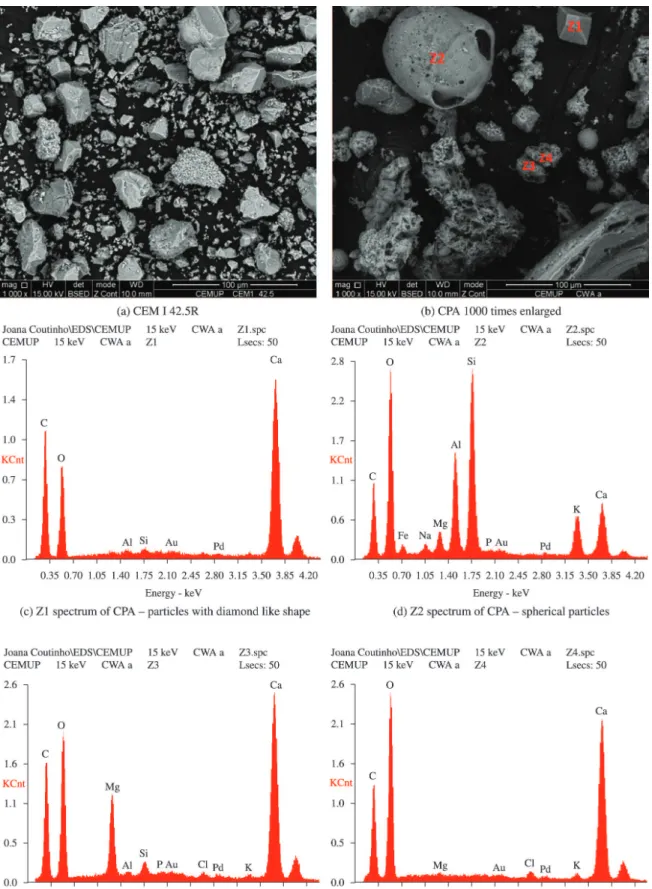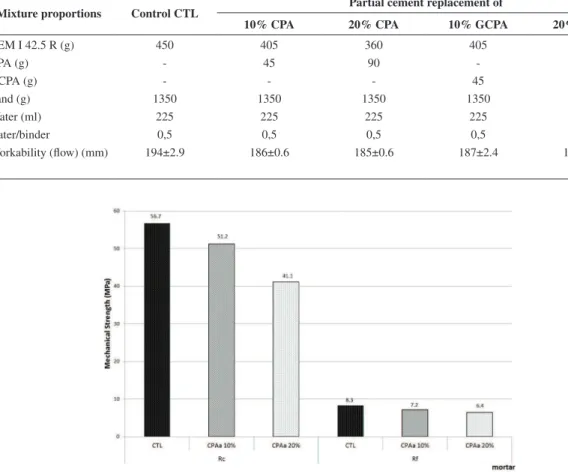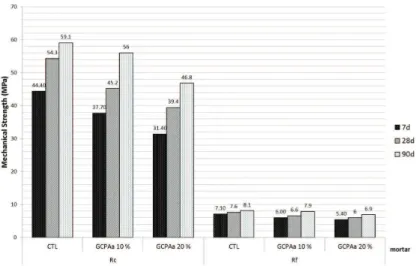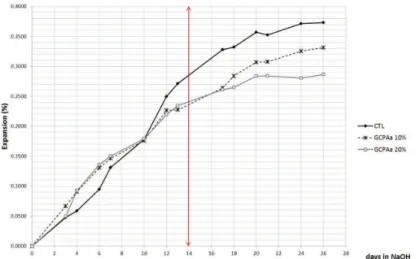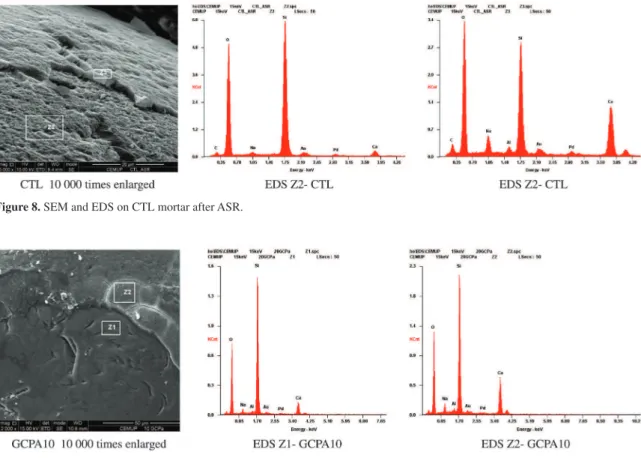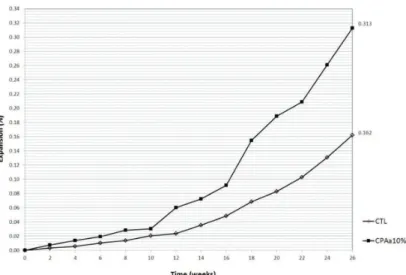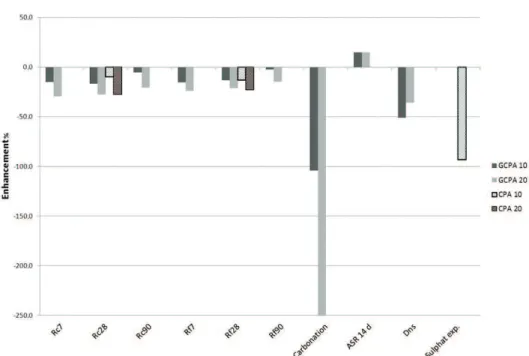2014; 17(4): 893-907 © 2014 Materials Research.
OI:
D http://dx.doi.org/10.1590/S1516-14392014005000092
*e-mail: anamatos@fe.up.pt
Strength and Durability of Mortar Using Cork Waste Ash as Cement Replacement
Telma Ramosa, Ana Mafalda Matosb*, Joana Sousa-Coutinhoc
aLaboratory for the Concrete Technology and Structural Behaviour – LABEST,
Department of Civil Engineering, Faculty of Engineering – FEUP, University of Porto, Rua do Dr. Roberto Frias, s/n, 4200-465 Porto, Portugal
bLaboratory of Test of Building Materials – LEMC, Department of Civil Engineering, Faculty of
Engineering – FEUP, University of Porto, Rua do Dr. Roberto Frias, s/n, 4200-465 Porto, Portugal
cDepartment of Civil Engineering, Faculty of Engineering – FEUP, University of Porto, Rua do Dr.
Roberto Frias, s/n, 4200-465 Porto, Portugal
Received: January 22, 2014; Revised: April 23, 2014
Cork powder, the major waste from cork processing industries, is generated from grinding, cutting and finishing operations throughout the industrial cork process. Cork powder has been used mainly as fuel in cork industries. Cork waste ash is usually landfilled but if efficiently used in cement based construction materials it could contribute to sustainability. Strength and durability testing was undergone on mortar with 10 and 20% cement replacement with cork waste ash. Although strength is acceptable for 10% cement replacement with cork ash (5% loss at 90 days, compared to control), most durability properties (tested up to 6 months according to test type) reduced performance probably due to a broader pore structure caused by coarse particles in the ash which tested non pozzolanic. Moreover, cork waste ash does not present the necessary requirements in terms of chemical properties considering several standards. Present work has revealed that this cork waste cannot be used as a pozzolan or as a filler in cement based materials. In fact it is known that chemical composition of biomass ash is highly variable due to moisture variations, ash yield and different genetic types of inorganic matter in biomass and therefore it is important to pinpoint which types of biomass waste are adequate or not to use as cement replacement in construction.
Keywords: cork waste ash, sustainability, durability, mortar, concrete
1. Introduction
Cementitious materials, mainly in the form of concrete, are the most successful materials in the world. Every year more than 1m3 is produced per person worldwide. The
huge volumes of cement and concrete produced mean that cement production accounts for some 5-8% of man-made CO2 emissions. Therefore there is increasing pressure to innovate to improve sustainability1.
At the same time, public and political awareness on the issue of environmental degradation has intensified. Therefore construction and, in particular, concrete must keep evolving to satisfy the increasing demands of all its users with sustainability as a backing force. Reuse of post-consumer wastes and industrial by-products in concrete is necessary to produce “greener” concrete. Recycling by-products is an environmental-friendly method for large quantities of materials that may otherwise pollute land, water, and air2.
Despite the existence of large amounts of industrial waste such as blast furnace slag, fly ash, silica fume, slag and agricultural residues such as rice husk ash, which have been used for many years in large amount as raw materials
and components in the cement industry, there are still many other industrial wastes not used yet3.
Portugal is the leading producer of cork with 52% of world production4. The most important waste from cork
processing is “cork powder”, a term used to cover all cork wastes comprising crude cork impurities, cork material powder, cork particles having dimensions lower than permitted for granulates (usually lower than 0.5mm), and sometimes larger pieces. “Cork powder” is produced in all industrial cork processing systems originated in various industrial operations and based on different cork types which are used in the production of multiple cork products. This material has been used mainly as combustion fuel in cork industries, while a small fraction is used as filling agent (mixed with glues) for the worst quality cork stoppers and for linoleum production. It may also be used for example in the manufacture of explosives and agriculture. Cork ash is usually deposited in landfill5 which is not sustainable. One
of the major problems of cork fly ash and cork bottom ash is the effect on environment such as air pollution, due to fineness and groundwater quality, due to possible leaching of metals6.
894 Ramos et al. Materials Research
of such waste materials appears to be a viable solution, not only for pollution, but also for land-filling and high cost of building materials7.
The practice of industrial ecology implies that waste products of one industry are recycled as substitutes for raw materials of other industries, thereby reducing environmental impact of both industries.
Cork granules have been studied for application in other industries, namely in the construction industry. In fact, a research study was carried out to use cork granules in lightweight concrete. Results indicated that the addition of cork considerably reduces the density of the composite and enhances failure strain. These properties of the composite are attributed to the cellular structure of cork. Cork presents a low specific weight, great elasticity, flexibility and durability, specific stiffness and strength, impermeability to liquid and gases, resistance to wear and fire, dimensional stability and resistance to reactive agents and microorganisms5.
The viability and feasibility of combining waste cork with cementing materials considering fresh and hardened material properties, was also investigated. It could be concluded that the greatest 3 and 7 day cube strengths were achieved by 24 h moisture saturation followed by draining of the cork, prior to use in concrete. Finer cork sizes were most beneficial to achieve optimum mechanical and transport properties. However, high permeability values indicated that concrete-cork composites considered in this study may be vulnerable to poor durability performance8.
Authors of the present study were previously involved in research considering use of cork powder in self compacting concrete to replace fine material, which proved to be a successful application of this waste material9.
To knowledge of the authors, no research has yet been carried out on cork waste ash as a cement replacement material in cement based composites such as mortar and concrete. The cork industry which supplied cork waste ash for this study produces, on its own, around 800 tons a year of this waste material which has no application so far. Therefore, the aim of this research was to study the potential of using cork waste ash as a partial substitute of cement in mortar so as to assess potential use of this waste in concrete. The study involved a first characterization of cork waste ash including chemical analyses, Scanning Electron Microscopy (SEM) and laser particle size distribution. Then, mechanical and durability properties were assessed, such as alkali-silica reaction resistance (ASR), resistance to chloride ion diffusion and resistance to external sulphate attack. These properties were determined on mortar with different cement replacement dosages as well as for different fineness levels of cork waste ash.
2. Material and Methods
2.1.
Materials
Type I 42.5R Portland cement (specific gravity 3.16g/ cm3) was used. This cement contains at least 95% Portland
cement clinker, therefore the most suitable for this type of study.
Cork waste ash from a Portuguese industry, was dried at 105±5°C for 24 hours. The dried material is henceforward referred to as CPA (Cork waste ash). A finer material, referred to as GCPA (ground cork waste ash) was obtained from CPA submitted to grinding in a planetary mill RETCSH PM 100, using zirconia balls of 1 mm diameter, for 10 minutes at constant 450 rpm.
Particle size distribution and chemical composition of CPA and GCPA are shown in Table 1 and Table 2, respectively.
Pozzolanic activity was assessed by comparing the concentration of calcium ion, expressed as calcium oxide, present in the aqueous solution containing the binder, in this case 90% cement and 10% CPA, after 15 days, with the quantity of calcium ion capable of saturating a solution of the same alkalinity, as described in NP EN 196-510. The
binder tests positive for pozzolanicity, if the concentration of calcium ion in the solution is lower than the saturation concentration. Results obtained were a CaO concentration of about 13.6 mmol/l and a OH- concentration of 48 mmol/l, leading to a negative result.
Figure 1 shows Scanning Electron Microscopy (SEM) carried out on cement and CPA/GCPA samples. As can be observed CPA particles are coarser than cement particles. Many particles have a spongy like appearance, possessing a variety of shapes.
2.2.
Mortar production
Four mortar types were prepared following the procedure described in NP EN 196-111 a control mix with
100% cement (CTL), two mixes with 10% (CPA 10% and GCPA 10%) cement replacement with cork waste ash (CPA) or ground cork waste ash (GCPA), respectively, and two mixes with 20% (CPA 20% and GCPA 20%) cement replacement with CPA and GCPA, respectively. Mixture proportions are shown in Table 3.
Mortar workability was measured according to ASTM C 10912 and ASTM C 23013, and results are given in Table 3.
2.3.
Strength
Flexural and compressive strength testing was undertaken on 40×40 mm x 160mm mortar specimens, following standard procedure in NP EN 196-111 at 28 days
for CTL, CPA10 and CPA20 and at 7, 28 and 90 days for CTL, GCPA10 and GCPA20. These 2 studies were conducted separately and results of flexural and compressive strength are presented in Figure 2 and Figure 3, respectively.
2.4.
Carbonation
Resistance to carbonation was assessed in accordance with the procedure described in RILEM CPC-1814.
Carbonated depth was evaluated on three test specimens for
Table 1. Particle size distribution of cement, CPA and GCPA.
d(10) µm d(50) µm d(90) µm
CEM I 42,5 R 0.69 8.09 30.81
CPA 10.36 31.59 71.25
2014; 17(4)
895
Strength and Durability of Mortar Using Cork
W
aste
Ash as Cement Replacement
Table 2. Chemical and physical properties of cork waste ash and requirements in standards.
Chemical composition and requirements
GCPA | CPA (%) Standards
NP 422025 NP EN 450-126 ASTM C 61827 NP EN 1262028
SiO2 38.15 ≥25%
Al2O3 3.65
Fe total 1.95
SiO2+Al2O3+Fe2O3 43.75 Mainly SiO2+Al2O3+Fe2O3 ≥70% ≥70%
CaO 35.88 ≤2.5% free CaO
≤10% Reactive CaO or
≤10% total CaO according NP EN 196-2
≤2.5% free CaO
≤25% Reactive CaO CaO free
10.80
MgO 1.41 ≤4%
Na2O 0.32
K2O 2.13
Na2Oeq 1.72 Na2Oeq≤5% Na2Oeq≤5%
TiO2 0.28
P2O5 0.87 5% (coal fly ash)
SO3 0.77 ≤3% ≤3% ≤4.0% ≤0.2
Cl Not determined ≤0.1% ≤0.1% ≤ 0.1
LOI
14.86
Category A ≤ 5.0% Category B ≤ 7.0% Category C ≤ 9.0%
≤10.0%
≤ 9%
Pozzolanicity Negative Positive Positive
Physical properties and requirements
GCPA | CPA NP 422025 NP EN 450-126 ASTM 61827
Specific gravity (g/cm3) 2.601
Activity Index (%) 83 | 90 (GCPA10 | CPA10)
73 | 72.5 (GCPA20 | CPA20)
≥ 90% class POZ90/10* (28 days)
≥ 80% class POZ80/20* (28 days)
For 25% fly-ash:
≥ 75% (28 days) ≥ 85% (90 days)
≥ 75% (7 days)
≥ 75% (28 days)
Setting time -- ≤ (120 min + setting time of cement) ≤ (120 min + setting time of cement)
Final setting time -- ---
---Expansibility -- ≤ 10 mm ≤ 10 mm
*POZ 90/10. Pozzolanic class identified by the cement/pozzolan ratio which tests positive in the pozzolanicity test according to NP EN 196-510. In this case 90% reference cement and 10% cork waste ash and in the case of POZ
896 Ramos et al. Materials Research
2014; 17(4) Strength and Durability of Mortar Using Cork Waste Ash as Cement Replacement 897
each mortar type, water cured at 20°C for the first 14 days followed by 14 days at 20°C and 50% Relative Humidity (RH) and then 90 days in the accelerated carbonation chamber with 5±0.1% carbon dioxide, RH of 60±5% and temperature of 23±3°C After splitting the specimens, the surface was cleaned and sprayed with a phenolphthalein pH indicator. In the noncarbonated part of the specimen, where the mortar was still highly alkaline, a purple-red colour was obtained. In the carbonated part of the specimen where the alkalinity of mortar is reduced, no coloration occurred. Each value corresponds to the mean of twelve measurements taken around the four sides of the freshly split and sprayed surface of each test specimen. The results can be seen in Figure 4.
2.5.
Alkalis silica reaction and SEM observations
In order to measure the ASR expansion for a given mix proportion, an accelerated mortar bar test was carried out on three 25×25×250 mm specimens of in accordance with ASTM C156715.Mortar bar specimens were demoulded at 24 hours and then stored in distilled water at 80°C for another 24 hours, after which a zero reading was taken. The bars were then transferred and immersed in 1N NaOH (1 Normal Sodium Hydroxide) solution at 80 °C and periodically measured up to the following 28 days.
Expansion of each mortar bar was measured within 15±5 s after being removed from the 80°C distilled water or alkali storage condition by using a length gauge. Average expansion with time, up to 28 days and average expansion at 14 days of each mortar type are shown in Figures 5 and 6.
Combinations of cement, pozzolanic materials and aggregate that expand more than 0.1% (at 14 days) are indicative of potentially deleterious expansion. However, in the case of indication of deleterious expansion should be confirmed by testing the same combination of materials in concrete.
After testing for ASR, SEM and EDX spectrums were undertaken on GCPA and CTL mortar specimens after 28 days testing as shown in Figure 7 through to Figure 9.
2.6. Chloride ion diffusion
The CTH rapid method is a non-steady-state migration method based on a theoretical relationship between diffusion and migration which enables the calculation of the chloride diffusion coefficient from an accelerated test16,17.
It is based on measuring the depth of colour change of a silver nitrate solution sprayed on specimens previously submitted to a migration test and application of the following Equation 1 and 2.
Table 3. Mixture proportions and workability of mortars.
Mixture proportions Control CTL Partial cement replacement of
10% CPA 20% CPA 10% GCPA 20% GCPA
CEM I 42.5 R (g) 450 405 360 405 360
CPA (g) - 45 90 -
-GCPA (g) - - - 45 90
Sand (g) 1350 1350 1350 1350 1350
Water (ml) 225 225 225 225 225
water/binder 0,5 0,5 0,5 0,5 0,5
Workability (flow) (mm) 194±2.9 186±0.6 185±0.6 187±2.4 189±4.4
898 Ramos et al. Materials Research
α
= d– d
ns
x x
RTL D
ZFU t (1)
–1
0
2
2 RTL , erf 1 Cd
ZFU C
α = ε ε = −
(2)
Where Dns is the apparent diffusion coefficient obtained in a non-steady-state migration test (cm2 s–1); R the gas
constant R=8.314 J (mol K)–1; T the absolute temperature
(K); L the thickness of specimen (cm); Z the ion valence; F is Faraday constant; F=9.648×104J (V mol); U the effective
voltage applied (V); xd the depth of chloride penetration measured by using a colorimetric method (cm); t the time of the test duration (s); α the laboratory constant; ε = 0.0764 if external chloride concentration of 0,5 M; C
d
the concentration of free chloride at which the color changes when using the colorimetric method to measure the chloride penetration depth (kg/m3
solition); and C0 is the concentration
of free chloride in the external solution.
The procedure for determining the apparent diffusion coefficient (Dns) consisted of: after switching off the electrical field the specimens were split in two halves and the penetration of chlorides was measured by using the colorimetric method. This method consists of spraying silver nitrate solution over the split faces, storing them in a dark place for an hour and then exposing them under a fluorescent light for a few hours, after which the average front of the white zone in the central part of each specimen is measured with a precision of 0.5 mm. Apparent diffusion coefficient Dns results are shown in Figure 10.
Test specimens were water cured for 90 days prior to testing.
2.7.
External sulphate attack
Resistance to external sulphate attack was evaluated on CTL and CPA10 mortar types according to the Portuguese standard E – 46218, on six (1, 2, 3, 4, 5 and 6) mortar prisms
of 20×20×160 mm. Test specimens were immersed in calcium hydroxide solution during 28 days. Then, length was Figure 3. Flexural (Rf) and compressive strength (Rc) results at 7, 28 and 90 days for GCPA.
2014; 17(4) Strength and Durability of Mortar Using Cork Waste Ash as Cement Replacement 899
measured along the 4 side faces of each specimen and taken as the initial readings (L0). Test specimens 2, 4 and 6 were
transferred to a sodium sulphate solution and the remaining specimens were maintained in calcium hydroxide saturated solution. Readings were taken throughout 26 weeks and sulphate solution was renewed every 2 weeks. The actual length increase of each specimen on day x is taken as:
2
( ) ( ) 0
1600
Ca OH Lx L
Exp x = − (3)
4 2( ) 0
1600
SO Na Lx L
Exp x = − (4)
2
( ) (1) (3) (5)
3
Ca OH Exp Exp Exp
Exp = + + (5)
4 2 (2) (4) (6)
3
SO Na Exp Exp Exp
Exp = + + (6)
The expansion due to sulphate is:
( )
4 2 ( )2Expansion x =ExpSO Na −ExpCa OH (7)
Expansion along 26 weeks is shown in Figure 11. After testing for external sulphate attack, SEM and EDX spectrums were undertaken on CPA and CTL mortar specimens after 26 weeks testing as shown in Figures 12 to 15.
3. Discussion
3.1. Chemical and physical properties of CPA
As can be seen from Table 2, cork waste ash is mainly composed of silica and calcium oxide of which 11 % is free CaO.Free lime if inter-crystallized with other compounds may only be partially exposed to water before setting19 and
thus cause expansion in hardened cementitious composites. Figure 5. ASR expansion versus time.
900 Ramos et al. Materials Research
Therefore free lime content should be low which is not the case in this waste material.
Loss on ignition, LOI, presents a high value. However, even higher values, up to 58%, have been reported by other researchers for wood waste ash20. Relatively high
LOI in comparison to other type of cement replacement materials namely silica fume and metakaolin may imply a certain degree of inefficiency in the conversion of carbon20.
Nevertheless, LOI includes not only carbon content but also any combined water or fixed CO2 present19 usually rendering
high water absorption of ash. Moreover it is possible that part of LOI may be attributed to CaCO3 in the ash which has been found in other types of ash obtained from agro-industrial waste. In fact calcium carbonate was confirmed by XRD in sawdust ash by21 and in forest waste ash by22.
Poykio et al.23 also state that calcium carbonate in a high
2014; 17(4) Strength and Durability of Mortar Using Cork Waste Ash as Cement Replacement 901
percentage is typically observed in forest waste ash and that although Loss of Ignition is widely attributed to the amount of combustible matter in the sample (especially for coal fly ash), it may not represent rightly the amount of unburnt carbon in ash but rather the volatile fraction23. In fact calcium
carbonate leads to CaO and CO2 on heating below 1000°C, the temperature used for determining Loss of Ignition in (LOI) in accordance with NP EN 196-224.
Chemical and physical properties of cork waste were compared to requirements in various standards as presented in Table 2. NP 422025 refers to pozzolanic materials in
Portugal, NP EN 450-126 to fly ash in Europe which may
result from firing of pulverised coal fired simultaneously with co-combustion materials such as vegetable material (like cork waste) and ASTM C 61827 refers to coal fly ash or
raw or calcined natural pozzolan for use in concrete. As cork Figure 8. SEM and EDS on CTL mortar after ASR.
Figure 9. SEM and EDS on GCPA10 mortar after 28 day ASR testing.
902 Ramos et al. Materials Research
waste ash does not seem to show pozzolanic activity, testing negative for Pozzolanicity, this material was also matched up to filler in accordance with the European standard NP EN 1262028 in terms of chemical properties. However sulphate
content surpasses the limit stated in this standard. As can be seen, properties of cork waste ash fail some of the requirements for each of these standards: The total value of the three oxides SiO2, Al2O3 and Fe2O3 is well below the minimum, where demanded, free CaO and LOI overpass limits where stated and, as referred to, pozzolanicity did not test positive, as required in NP 422025.
Through SEM observations (Figure 1), it is shown that cork waste ash is composed of particles with different shapes and sizes. Three main types of particles were observed, diamond shaped, spherical, and spongy like, usually formless. These types of particles proved to be chemically different. Diamond shaped particles seem to be essentially composed of CaO as can be seen in EDS spectrum Z1. Spherical particles, some hollow as in Z2, are also present and of complex composition probably SiO2, Al2O3, Fe2O3
,CaO, MgO, as well as alkalis.
According to Mehta and Monteiro29, although most
of the particles in fly ash occur as solid spheres of glass, sometimes a small number of hollow spheres called
cenospheres may also be present29. In the case of fly ash
from cork waste this may also be expected.
Spongy like particles, mostly formless, seem to be mainly composed of CaO and MgO. These particles seem abundant and their size relatively greater compared to other CPA particles and also to cement particles, thus confirming particle size distribution presented in Table 1 where it can be seen that CPA is coarser than cement. GCPA is also coarser than cement but grinding CPA to obtain GCPA affected mostly medium and smaller sized particles and less coarser particles, which are probably harder, maybe due to different chemical composition according to size.
Generally, EDS spectrums of the different particles confirmed chemical composition presented in Table 2.
3.2.
Strength and activity index
Considering flexural and compressive strength, Figure 2 for CPA and Figure 3 for GCPA, it can be seen that cork ash reduces strength and that strength loss is greater with increasing percentage replacement. However at 90 days for GCPA 10% replacement there is a strength loss of only 5% when compared to control and for GCPA 20% replacement, strength loss soars up to 21%, compared to control, as can be seen in Figure 16. This could indicate Figure 11. Expansion during 26 weeks due to sulphate testing.
2014; 17(4) Strength and Durability of Mortar Using Cork Waste Ash as Cement Replacement 903
some mild pozzolanic activity although not sufficient to induce a positive Pozzolanicity test.
In terms of strength and therefore Activity Index, results (Table 2) generally fail requirements in standards related to pozzolanic materials. In fact, considering NP 422025, at
28 days, CPA reached the minimum required of 90% for
the Activity Index in POZ 90/10, this is, for 10% cement replacement with cork waste ash.
904 Ramos et al. Materials Research
where the Activity Indexes were 83% and 73%, both under the thresholds of 90% and 80%, respectively.
When comparing CPA 10% to GCPA 10%, it is interesting to observe that for this percentage replacement grinding may not be required in terms of strength, lowering production costs.
Unsatisfactory strength results can also be observed in terms of the fly-ash standard where Activity Indexes of 75% and 85% are required at 28 days and 90 days respectively for 25% cement replacement. A replacement level of 20% led to Activity Indexes already below these limits for 28 days (AI=73%, for CPA and GCPA) and 90 days (AI=79% for GCPA) and therefore anticipating even lower values for the required 25% replacement. If ASTM C 618 (2012) is used then strength must be compared at 7 and 28 days with a minimum Activity Index of 75%, disregarding percentage replacement. For GCPA, Activity Index is 85% and 71% for 10% and 20% cement replacement, respectively at 7 days and 83% and 73%, respectively at 28 days. Therefore GCPA used as 10% cement replacement does agree with ASTM C 61827 strength requirements, but not for a 20%
cement replacement.
In addition to the cement content reduction, the decrease in strength may be attributed to the increased amount of free water due to reduced amount of material available to react with the water, since cork waste ash is not fully pozzolanic and consists of larger particles and thus lower specific surface reacting – despite the constant w/c ratio used for each mix. The resulting pores in the GCPA or CPA matrixes must be wider compared to the control matrix leading to less dense and more permeable mortar. This will obviously have implications in the durability related properties of cork waste ash mortar.
3.3.
Carbonation, alkali silica reaction, chloride
diffusion, sulphate attack
Carbonation depth for all blended cement mixtures was greater than for the Portland cement mixture. It was found that carbonation increased along with the increase in GCPA content as expected, due to a more permeable mortar but also to CH reduction. Increasing GCPA replacement results in less cement in the mixture, contributing to CH reduction. ASR expansion results showed a decreasing expansion in mortar with GCPA compared to CTL.
Increasing the cement dosage replacement by GCPA (10% to 20%) did not affect ASR expansion. Both samples exhibited formation of alkalis-silica gel over deeply grooved surfaces of reactive aggregate. However, cork waste ash content led to slightly lower expansion despite slightly higher alkali content (Na2Oeq of cement = 1.31%). It is possible that gel formed in GCPA mortar was better sustained in the coarser pore system. According to Hobbs30
in concretes containing reactive aggregate which has not shown deleterious expansion due to ASR, gel can often be found filling or partially filling air voids, so that expansion is not observed.
SEM observations were carried out after ASR testing as can be seen in Figures 7, 8 and 9. Gel found on mortar samples, (Figure 8c) Figure 9c)) essentially composed of Si, Ca and Na, appear in the aggregate paste interface. Attacked aggregate presented grooves and gel.
CTH rapid method results show that using GCPA as a partial cement replacement decreases resistance to chloride penetration compared to control mortar especially for 10% replacement. For GCPA 20% the apparent diffusion coefficient was slightly smaller. Incorporation of GCPA, which presents coarser particles compared to cement, led to a more permeable structure.
Sulphate expansion at 26 weeks should be below 0.1% according to the Portuguese standard E-462 and therefore Portland cement used proved not to be sulphate resistant. Incorporating CPA (10%) reduced even further resistance to sulphates. According to Figure 11, CTL and CPA 10% mortar expansion rates were low at the beginning and increased substantially after 10 weeks of immersion in Na2SO4. This result may be explained because as CPA is not fully pozollanic, portlandite (CH) is available to react with sulphates, promoting the formation of gypsum31.
Regarding SEM and EDS observations, as can be seen in Figure 12 and Figure 13, dispersed plates of gypsum and ettringite were found in CPA mortar.
In case of the CTL mortar, Figure 14 and Figure 15 showed ettringite layers and occasionally structures which seem thaumasite.
2014; 17(4) Strength and Durability of Mortar Using Cork Waste Ash as Cement Replacement 905
Figure 16. Performance of mortars compared to CTL mortar.
906 Ramos et al. Materials Research
negative result corresponds to a reduction in performance. These results are shown in Figure 16.
4. Conclusion
The present study was intended to evaluate use of cork waste ash in cement based materials and the following conclusions can be drawn:
• In terms of physical and chemical characteristics,
CPA cannot be considered a pozzolanic-cementitious material according to requirements in ASTM 61827
and fail several requirements in NP EN 450-126 for
fly ash and in the Portuguese standard for pozollanic materials, NP 422025. Tested non pozzolanic, CPA
cannot be considered as a filler because of high sulphate content;
• Althoughreasonablestrengthwasobtainedfor10%
cement replacement with cork waste ash, in terms of
durability and as can be seen in Figure 16, cork waste ash reduced performance except for ASR which may be explained by accommodation of gel in the broader pore structure resulting from coarser non-reactive cork waste ash particles.
It has been confirmed that chemical composition of biomass and especially ash components are highly variable due to the extremely high variations of moisture, ash yield, and different genetic types of inorganic matter in biomass32.
Therefore it is important to pinpoint which types of biomass waste are adequate or not to use as cement replacement in construction.
Acknowledgments
The authors would like to thank LEMC, LABEST, SECIL and AMORIM CORK industry. This work was financed by FEDER funds under the Operational Program
Factors of Competiveness – COMPETE and by National Funds under FCT - Foundation for Science and Technology
through project PTDC/ECM/098117/2008 Additions from waste materials for sustainable structural concrete.
References
1. Scrivener KL and Kirkpatrick RJ. Innovation in use and research on cementitious material. Cement and Concrete
Research. 2008; 38(2):128-136. http://dx.doi.org/10.1016/j.
cemconres.2007.09.025
2. Mehta PK. Mineral admixtures for concrete: an overview of recent developments. In: Proceedings of an Engineering
Foundation Conference: Advances in Cement and Concrete.
1994; Durham. Durham: ASCE. p. 243-256.
3. Gil L. Cork powder waste: an overview. Biomass and
Bioenergy. 1997; 13(1-2):59-61. http://dx.doi.org/10.1016/
S0961-9534(97)00033-0
4. Fonseca TJF and Parresol BR. A new model for cork weight estimation in Northern Portugal with methodology for construction of confidence intervals. Forest Ecology
and Management. 2001; 152(1-3):131-139. http://dx.doi.
org/10.1016/S0378-1127(00)00590-9
5. Reis PNB, Ferreira JAM and Silva PAA. Mechanical behaviour of composites filled by agro-waste materials. Fibers and
Polymers. 2011; 12(2):240-246. http://dx.doi.org/10.1007/
s12221-011-0240-z
6. Cheerarot R and Jaturapitakkul C. A study of disposed fly ash from landfill to replace Portland cement. Waste
Management. 2004; 24(7):701-709. PMid:15288302. http://
dx.doi.org/10.1016/j.wasman.2004.02.003
7. Madurwar MV, Ralegaonkar RV and Mandavgane SA. Application of agro-waste for sustainable construction materials: a review. Construction and Building Materials. 2013; 38:872-878. http://dx.doi.org/10.1016/j.conbuildmat.2012.09.011 8. Panesar DK and Shindman B. The mechanical, transport and
thermal properties of mortar and concrete containing waste cork. Cement and Concrete Composites. 2012; 34(9):982-992. http://dx.doi.org/10.1016/j.cemconcomp.2012.06.003 9. Pereira PMP. Corkcrete - Betão auto-compactável com finos de
cortiça. [Thesis]. Porto: University of Porto; 2012.
10. Instituto Portugues da Qualidade – IPQ. NP EN 196-5: methods of testing cement. Part 5: pozzolanicity test for pozzolanic cement. Lisbon: IPQ; 2011.
11. Instituto Portugues da Qualidade – IPQ. EN 196-1: methods of testing cement. Part 1: determination of strength. Lisbon: IPQ; 2006.
12. American Society for Testing and Materials – ASTM. C109/
C109M-11: Standard test method for compressive strength
of hydraulic cement mortars (using 2 in. or [50 mm] cube specimens). West Conshohocken: ASTM; 2011.
13. American Society for Testing and Materials – ASTM. C230/
C230M-08: Standard specification for flow table for use in tests
of hydraulic cement. Philadelphia: ASTM; 2008.
14. RILEM. CPC-18: measurement of hardened concrete carbonation depth. Materials and Structures. 1984; 17(102):435-440.
15. American Society for Testing and Materials – ASTM. C1567-11: Standard test Method for determining the potencial Alkali-Silica reactivity of combinations of Cementitious Materials and Aggregate (Accelerated Mortar-Bar Method). United States: ASTM; 2011.
16. Laboratório Nacional de Engenharia Civil – LNEC.
Determinação do coeficiente de difusão dos cloretos por ensaio
de migração em regime não estacionário. Lisbon: LNEC; 2008.
Lista especificações LNEC E 463.
17. Nordtest Method. NT build 492. Concrete, mortar and cement-based repair materials: chloride migration coefficient from non-steady-state migration experiments. Finland; 1999. 18. Laboratório Nacional de Engenharia Civil – LNEC. Cimentos:
resistência dos cimentos ao ataque por sulfatos. Lisbon: LNEC; 2004. Lista especificações LNEC E 462.
19. Neville AM. Properties of concrete. 4th ed. England: Longman; 1998.
2014; 17(4) Strength and Durability of Mortar Using Cork Waste Ash as Cement Replacement 907
Resources, Conservation and Recycling. 2011; 55(7):669-685.
http://dx.doi.org/10.1016/j.resconrec.2011.02.002
21. Elinwa AU and Ejeh SP. Effects of incorporation of sawdust incineration fly ash in cement pastes and mortars. Journal of
Asian Architecture and Building Engineering. 2004; 3(1):1-7.
http://dx.doi.org/10.3130/jaabe.3.1
22. Rajamma R, Ball RJ, Tarelho LAC, Allen GC, Labrincha JA AND Ferreira VM. Characterisation and use of biomass fly ash in cement-based materials. Journal of Hazardous Materials. 2009; 172(2-3):1049-1060. PMid:19699034. http://dx.doi. org/10.1016/j.jhazmat.2009.07.109
23. Poykio R, Ronkkomaki H, Nurmesniemi H, Peramaki P, Popov K, Valimaki T et al. Chemical and physical properties of cyclone fly ash from the grate-fired boiler incinerating forest residues at a small municipal district plant (6MW). Journal of Hazardous
Materials. 2009; 162(2-3):1059-1064. PMid:18603362. http://
dx.doi.org/10.1016/j.jhazmat.2008.05.140
24. Instituto Portugues da Qualidade – IPQ. NP EN 196-2: methods of testing cement. Part 2: chemical analysis of cement. Lisbon: IPQ; 2006.
25. Instituto Portugues da Qualidade – IPQ. NP 4220: Pozolanas para betão, argamassas e caldas, definições, requisitos e verificação da conformidade. Lisbon: IPQ; 2010.
26. Instituto Portugues da Qualidade – IPQ. NP EN 450-1: fly ash for concrete. Part 1: definition, specification and conformity criteria. Lisbon: IPQ; 2012.
27. American Society for Testing and Materials – ASTM. C618: Standard Specification for Coal Fly Ash and Raw or Calcined Natural Pozzolan for use in concrete. Philadelphia: ASTM; 2012.
28. Instituto Portugues da Qualidade – IPQ. NP EN 12620. Aggregates for concrete. Lisbon: IPQ; 2010.
29. Mehta PK and Monteiro PJM. Concrete: microstructure, properties and materials. 3th ed. New York: McGraw-Hill; 2006.
30. Hobbs DW. Alkali-silica reaction in concrete. London: Thomas Telford; 1988. http://dx.doi.org/10.1680/aric.13179 31. Ayea T and Oguchi CT. Resistance of plain and blended cement
mortar exposed to severe sulphate attacks. Construction and
Building Materials. 2011; 25(6):2988-2996. http://dx.doi.
org/10.1016/j.conbuildmat.2010.11.106
32. Vassilev SV, Baxter D, Andersen LK and Vassileva CG. Review article: an overview of the chemical composition of biomass.

